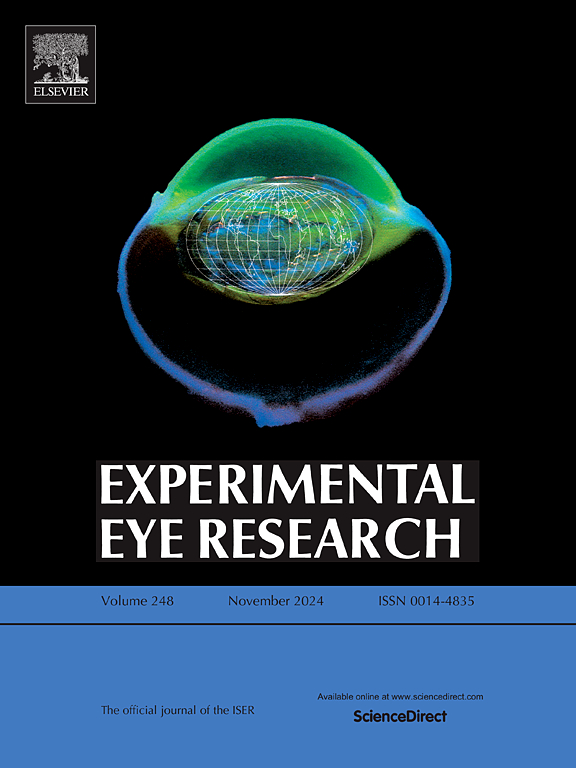Smartphone-based fundus imaging and computer vision analysis for monitoring retinopathy of prematurity in neonatal rats with and without lutein treatment
IF 3
2区 医学
Q1 OPHTHALMOLOGY
引用次数: 0
Abstract
Retinopathy of prematurity (ROP), caused by oxidative stress leading to abnormal retinal vessel growth, is often studied in rodent models. However, current methods rely on in vitro analysis, preventing the monitoring of disease progression. Fundus imaging is commonly used in clinical ophthalmology and could provide a method for in vivo imaging in rodents with ROP. Recently, a smartphone and condensing lens have been shown to be effective in humans and mice. The aim of this study was to develop a smartphone-based fundus camera system that can be used to monitor in vivo changes caused by ROP and determine its effectiveness upon introducing an intervention of lutein. KRN 633 was used to induce ROP and fundus imaging was conducted using a condensing lens and a smartphone. In vitro analysis of the retina was conducted for comparison using immunohistochemistry. The tortuosity was analyzed from fundus images manually using ImageJ and by a newly developed computer vision-based method. ROP induced tortuous arteries, which was improved by the administration of lutein in the fundus and microscopy images of the retina. The two imaging techniques showed a strong positive correlation. Similarly, the computer vision-based tortuosity analysis displayed a strong linear relationship with ImageJ analysis. This smartphone-based fundus camera system offers a cheap and accessible method for in vivo imaging to supplement traditional histological analysis. With future development, the image processing technique described can be enhanced to include other measures of visual function.
基于智能手机眼底成像和计算机视觉分析监测叶黄素治疗和未治疗的新生大鼠早产儿视网膜病变。
早产儿视网膜病变(ROP)是由氧化应激导致视网膜血管异常生长引起的,经常在啮齿动物模型中进行研究。然而,目前的方法依赖于体外分析,无法监测疾病进展。眼底成像是临床眼科中常用的一种成像方法,可以为ROP啮齿动物的体内成像提供一种方法。最近,智能手机和聚光透镜被证明对人类和老鼠都有效。本研究的目的是开发一种基于智能手机的眼底相机系统,该系统可用于监测由ROP引起的体内变化,并在引入叶黄素干预后确定其有效性。KRN 633诱导ROP,眼底成像采用聚光透镜和智能手机。采用免疫组织化学对视网膜进行体外分析比较。利用ImageJ和基于计算机视觉的新方法对眼底图像进行了扭曲度分析。ROP诱导动脉弯曲,眼底叶黄素和视网膜显微图像改善动脉弯曲。两种成像技术显示出很强的正相关。同样,基于计算机视觉的扭曲度分析与ImageJ分析显示出很强的线性关系。这种基于智能手机的眼底相机系统为体内成像提供了一种廉价且易于获取的方法,以补充传统的组织学分析。随着未来的发展,所描述的图像处理技术可以增强,以包括视觉功能的其他措施。
本文章由计算机程序翻译,如有差异,请以英文原文为准。
求助全文
约1分钟内获得全文
求助全文
来源期刊

Experimental eye research
医学-眼科学
CiteScore
6.80
自引率
5.90%
发文量
323
审稿时长
66 days
期刊介绍:
The primary goal of Experimental Eye Research is to publish original research papers on all aspects of experimental biology of the eye and ocular tissues that seek to define the mechanisms of normal function and/or disease. Studies of ocular tissues that encompass the disciplines of cell biology, developmental biology, genetics, molecular biology, physiology, biochemistry, biophysics, immunology or microbiology are most welcomed. Manuscripts that are purely clinical or in a surgical area of ophthalmology are not appropriate for submission to Experimental Eye Research and if received will be returned without review.
 求助内容:
求助内容: 应助结果提醒方式:
应助结果提醒方式:


